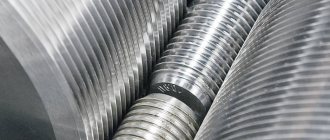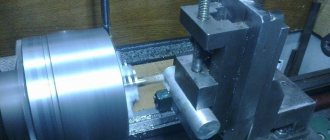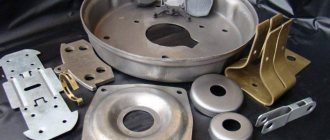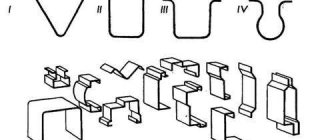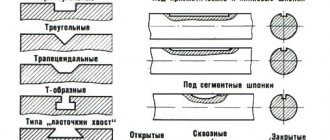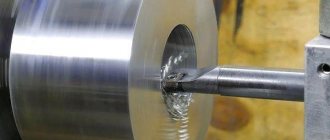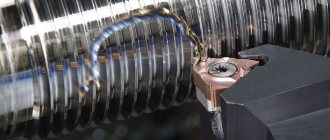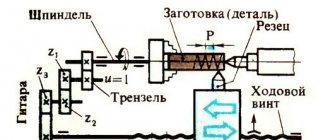Technological processing processes
TO
category:
Turning
Technological processing processes
Next: Installing cutters
A technological process is a part of the production process that contains targeted actions to change and determine the state of the workpiece. The technological process must indicate the processing sequence, workpiece dimensions L3 and Dz, processing allowances Ai and Dg (Fig. 141, a), installation and measuring bases, methods of fastening the workpiece, type of fixtures, need for cutting tools (Fig. 14.1, d , e, f), auxiliary (Fig. 141, b, c) and measuring (Fig. 141, g, h) tools.
A technological operation is a completed part of the technological process of processing one or more parts, which is performed at one workplace. The elements of a technological operation are installation and transition. The installation is the part of the technological operation performed while the workpieces being processed remain unchanged. The operation can be performed in one or more installations.
The technological process of manufacturing a part is shown step by step in Fig. 142. Installation (Fig. 143, a) and reinstallation of the workpiece is associated with its unfastening, reinstallation (Fig. 143, b) and new fastening.
A transition is a completed part of a technological operation performed on one of the surfaces of the workpiece using the same cutting tool at a set cutting mode.
Rice. 138. Gauge gauges for controlling shaft diameter
Rice. 139. Methods of measuring snob gauges (a), test gauges (b,c) and templates (d,e) of outer diameters
In Fig. Figure 144 shows how a part can be machined from start to finish in two setups. First, the worker clarifies the drawing of the part (Fig. 144, a), then determines the allowances for processing (Fig. 144.6). During the first installation (Fig. 144, c), the workpiece is completely processed on one side and cut off. Until the part is processed to all dimensions on one side and cut off, it is not removed from the machine. During the second installation (Fig. 144,d), the end of the head is trimmed and the chamfer is ground.
During machining, a layer of metal is sequentially removed from the surface at each operation of the technological process. There are general allowances zo, zo/2 and interoperational allowances z\ - General allowance - a layer of metal removed during all processing operations. Interoperational allowance is a layer of metal removed during one operation. The allowance indicated on the side (Fig. 145, a) is equal to the thickness of the layer being removed. Sometimes for cylindrical parts, the allowance is indicated by the diameter (Fig. 145, b), i.e., the allowance is equal to double the thickness of the layer being removed.
Rice. 140. Measuring a ring with a micrometer (b, c), a depth gauge (d) and a bore gauge (e)
The workpiece must be based in order to secure it in three mutually perpendicular planes XOY, XOZ and YOZ. In Fig. 146 shows the location of six workpiece mounting points. The XOY plane is called the installation base. There are three points 1, 2 and 3 on it, which determine the position of the installation base. Under the action of force P\u, this base deprives the workpiece of three degrees of freedom - movement along the ZO axis and rotation around the XO and OY axes. The XOZ plane is called the guide base. Points 4 and 5 are located on it. Under the action of force Pn, this base deprives the workpiece of two more degrees of freedom - movement along the OY axis and rotation around the ZO axis. The support base (point 6), located in the YOZ plane, deprives the workpiece of the last, sixth degree of freedom, namely the ability to move along the XO axis under the influence of force P\.
Rice. 141. Valve turning
The base is the initial surface, line, point or combination thereof, which determines the position of the part when it is installed on the machine and is used for basing. The design base (Fig. 147, a) is the base that determines the position of the part relative to another part in the product. The design bases from which the dimensions of the part are drawn in the drawing are called the main ones. Technological (Fig. 147, b) are called bases that determine the position of the workpiece when it is installed in a fixture during processing.
Rice. 142. Technological process of tone processing of a part: a—cutting the end; b—drilling; c—grinding of large diameter; d—grinding a smaller diameter for the thread; d—thread cutting; f—checking the thread with die gauge 1; g—cutting; h—cutting the end to size
In Fig. 148, a shows the base surface of a cylindrical workpiece clamped at three points by self-centering cams, and in Fig. 148.6—base surface of a cylindrical workpiece, based on the surface and clamped by three reverse self-centering cams. In Fig. 148, c shows the basing of a cylindrical workpiece along the center holes; in Fig. 148, g - the same basing using steady rest 2. Methods of basing and fastening workpieces when processing on a lathe are shown in Fig. 149.
Rice. 143. Installing and reinstalling the workpiece
Rice. 144. Valve processing diagram
Setting dimensions on drawings. Documentation for the manufacture of parts includes a drawing of the part and a technological map for its processing. The dimensions in the drawings are linear and angular. Linear dimensions (Fig. 150, a) are given in millimeters; the unit of measurement is not indicated. Angular dimensions are indicated in degrees, minutes and seconds (Fig. 150, b). Dimensions in the drawings are given without taking into account the scale of the image. The maximum deviation in the drawing is indicated in numerical terms or in the form of a symbol of the tolerance field (Fig. 151, a). When applying the diameter size of a part, put a 0 sign in front of the number, and the letters R or r in front of the radius size (Fig. 151.6).
Maximum deviations of dimensions (linear and angular) are indicated in the drawings. The maximum deviations of shafts (Fig. 152, a), holes (Fig. 152, 6) and mating elements (Fig. 152, c) can be indicated in one of three ways: I - symbols of tolerance fields; II - numerical values of maximum deviations; III - symbols of tolerance fields indicating on the right and in brackets the numerical values of maximum deviations (combined method). Maximum deviations of angular dimensions are indicated only by numerical values (Fig. 152, d). On a surface with one nominal size (Fig. 152, (9), which has sections with different maximum deviations, the boundary between sections is indicated by a solid thin line A, and the nominal size with the corresponding maximum deviations is plotted for each section separately.
Fig. 145. Allowances for processing: a—outer surface (end); b—inner surface (hole); z-|, z2, z3—interoperational allowances; сЦ, d2, d3—interoperational diameters
If it is necessary to specify a protruding location tolerance field (Fig. 153), then after the numerical value of the tolerance indicate the symbol P in a circle. The contour of the protruding part of the standardized element is limited by a thin solid line A, and the length and location of the protruding tolerance zone is limited by dimensions.
If the dependent tolerance is associated with the actual dimensions of the part, then after the numerical value of the tolerance the symbol M is placed in a circle (Fig. 154, a). If the dependent tolerance is associated with the actual dimensions of the base element, then the tolerance sign is placed in the third part of the frame after the letter designation of the base (Fig. 154, b) or without the letter designation (Fig. 154, c). If the dependent tolerance is associated with the actual dimensions of the base element under consideration, its symbol is placed after the numerical value and the letter designation of the base (Fig. 154, d) or without the letter designation of the base (Fig. 154, e).
Rice. 146. Basing the workpiece at six points
In Fig. 154, e indicates a tolerance of 0.04 mm for the cylindricity of the shaft; in Fig. 154, g - a tolerance of 0.01 mm for the roundness of the shaft and a tolerance of 0.08 mm for the profile of the longitudinal section of the shaft. In Fig. 154, h shows a tolerance of 0.03 mm perpendicular to the hole axis relative to the end; in Fig. 154, w - tolerance of 0.1 mm for radial runout of the surface relative to the common axis of surface A and B; in Fig. 154, k - tolerance of 0.1 mm for axial runout on a diameter of 20 mm relative to the axis of surface A.
Rice. 147. Design and technological bases
Rice. 148. Surfaces used for basing
Rice. 149. Methods for basing a workpiece: a—on a conical mandrel; b—on a tapered shank; c-cylindrical surface of the workpiece; g—along the annular protrusion; d—along the tapered shank and centering hole; e—by spherical shank and centering hole
Rice. 150. Designation of pineal and angular dimensions in drawings
The unified system of tolerances and landings provides for the following basic terms and their definitions (Fig. 155). Size - the numerical value of a linear quantity (diameter, length, etc.) in the selected units of measurement. Actual size is the size established by measurement with permissible error. Limit sizes - two maximum permissible sizes, between which the actual size must be or can be equal to.
The largest size limit is the larger of the two size limits. The smallest size limit is the smaller of the two size limits. Nominal size is the size relative to which the maximum dimensions are determined and which serves as the starting point for measuring deviations.
Deviation is the algebraic difference between the size (actual, limit, etc.) and the corresponding nominal size. The actual deviation is the algebraic difference between the actual and nominal sizes. The maximum deviation is the algebraic difference between the maximum and nominal sizes.
There are upper and lower deviations. The upper deviation is the algebraic difference between the largest limit and nominal sizes. The lower deviation is the algebraic difference between the smallest limit and nominal sizes.
Rice. 152. Examples of applying dimensions in drawings
Rice. 153. Examples of designation and location of the protruding field is allowed along the entire length of the standardized element (a) and at a length of 30 mm of the standardized element (6)
Rice. 154. Examples of designation of dependent tolerances of shape and arrangement of surfaces
In Fig. 156 shows the dimensions of a shaft with a diameter of 30Zo;2 mm. Nominal size 30 mm, largest limit size 29.9 mm, smallest limit size 29.8 mm, tolerance 29.9-29.8 = 0.1 mm; upper deviation 0.1 mm; lower deviation 0.2 mm. Line NN, indicating the nominal size, is called zero. Zero line is a line corresponding to the nominal size, from which dimensional deviations are plotted when graphically depicting tolerances and fits. If the zero line is located horizontally, then positive deviations are laid up from it, and negative ones are laid down.
Tolerance is the difference between the largest and smallest limit sizes or the absolute value of the algebraic difference between the upper and lower deviations. System tolerance (standard tolerance) - any of the tolerances established by a given system of tolerances and fits. In the standards, the word “tolerance” means “tolerance of the system.” Tolerance field is a field limited by upper and lower deviations. The tolerance field is determined by the size of the tolerance and its position relative to the nominal size. When shown graphically, the tolerance field is located between the upper and lower deviations relative to the zero line.
The main deviation is one of two deviations (upper or lower) used to determine the position of the tolerance field relative to the zero line (the main deviation is the deviation closest to the zero line). Quality - the level of gradation of system tolerance values. Each qualification contains a number of tolerances, which in the system of tolerances and landings are considered as corresponding to the same degree of accuracy for all nominal sizes.
Shaft is a term used to designate the external (male) elements of parts. It applies not only to cylindrical parts with a round cross-section, but also to elements of parts of other shapes. Hole is a term used to designate the internal (female) elements of parts of any shape. The main shaft is a shaft whose upper deviation is zero. The main hole is the hole whose lower deviation is zero.
Fit is the nature of the connection of parts, determined by the size of the resulting gaps or interference. The nominal fit size is the size common to the hole and shaft. Clearance is the difference between the sizes of the hole and the shaft when the size of the hole is larger than the size of the shaft. Preference is the difference between the size of the shaft and the hole before assembly, if the size of the shaft is larger than the size of the hole. Clearance fit - a fit in which a gap is provided in the connection. Landings with clearance also include fits in which the lower limit of the hole tolerance field coincides with the upper limit of the shaft tolerance field or is higher than the latter. An interference fit is a fit in which interference is provided in the connection. The hole tolerance field in such fits is located under the shaft tolerance field. Transitional fit - a fit in which both clearance and interference are possible. The tolerance field of the hole and shaft in such a fit overlaps partially or completely.
Rice. 155. Scheme of coupling the shaft with the hole: a—basic designations: ES—upper deviation of the hole, E I—lower deviation of the hole, ei—lower deviation of the shaft; es - upper shaft deviation; b – landings in the hole system; c – fits in the shaft system: 1 – shaft tolerance fields; 2 – tolerance range of the main hole; 3 – hole tolerance fields; Determination of clearance and interference. If a part with a hole with a diameter of 40+0-1 mm is placed on a shaft whose diameter is 40Zo;2 mm, i.e., always smaller than the hole, then there will be a gap in the connection of the shaft with the hole (Fig. 157, a). In this case, the fit will be with a gap, since the shaft will be able to rotate freely in the hole. If the diameter of the shaft is 40^o:is mm (Fig. 157.6), i.e., always larger than this hole, then to connect the shaft will have to be pressed into the hole and then an interference will be obtained in the connection.
The largest gap is equal to the difference between the largest maximum hole size and the smallest maximum shaft size: 40.1—39.8 = 0.3 mm; the smallest gap is equal to the difference between the smallest limit hole size and the largest limit shaft size: 40 - 39.9 = 0.1 mm. The maximum interference is equal to the difference between the largest maximum shaft size and the smallest maximum hole size: 40.2 - 40 = 0.2 mm; the smallest interference is equal to the difference between the smallest maximum shaft size and the largest maximum hole size: 40.15 - - 40.1 = 0.05 mm.
Fitting in a hole system is characterized by the fact that for all fits of the same quality, assigned to the same nominal diameter, the maximum hole dimensions remain constant. The implementation of various landings is achieved by correspondingly changing the maximum dimensions of the shaft. In a hole system, the nominal size is the smallest limiting size (Fig. 158, a).
Rice. 156. Illustration of shaft tolerances
Rice. 157. Connection of shaft and hole with clearance (a) and interference (b)
The shaft system is characterized by the fact that for all fits of the same quality, assigned to the same nominal diameter, the maximum dimensions of the shaft remain constant. Various fits are achieved by appropriately changing the maximum hole dimensions. In a shaft system, the nominal size is the largest limiting size of the shaft (Fig. 158.6). Both sides are asymmetrical, and the hole tolerance in the hole system will always be directed towards increasing the hole diameter (into the body), and the shaft tolerance in the shaft system will always be directed towards decreasing the shaft diameter (into the body).
Rice. 158. Location of holes and shafts: a—seventh grade accuracy h7 in the hole system; 6-seventh grade precision N7 in the shaft system
Turning principle
Turning is a type of machining of continuously rotating workpieces, which is used to create parts such as rotating bodies by removing excess material.
Turning requires a lathe, a workpiece, a clamping/holding fixture, and a cutting tool. The workpiece is a fragment of a rolled profile with a round cross-section, which is fixed in a working fixture. The latter, in turn, is itself attached to the lathe, allowing its rotation at a fairly high speed. The cutter that performs the shaping is usually a single-point (sometimes multi-point) cutting tool, which is also fixed in the lathe. The cutting tool is fed to the rotating workpiece and, in the process of forceful contact with it, cuts off the material in the form of small chips.
In the production of rotating, usually axisymmetrical parts, turning is used for:
- Obtaining holes - smooth and for subsequent threads.
- Production of grooves and fillet grooves.
- Obtaining conical surfaces.
- Performing stepped diametrical transitions.
Turning can also produce shaped surfaces. For this purpose, automatic machines or turning machining centers are used, which have the ability to automatically reinstall the cutter/cutters.
Parts that are manufactured exclusively by turning are often used with a limited production program. These can be reference prototypes of shafts or fasteners, which are produced to order and then used to develop technological solutions in mass production. Lathe processing is often used as a secondary (or finishing) process when it is necessary to introduce some characteristics of the contour of a part to improve its geometric characteristics obtained, for example, by hot stamping. Thanks to the close tolerances and high surface quality that turning can offer, the process is ideal for creating precision parts such as rotary bodies.
Processing of workpieces on screw-cutting lathes
Turning
Lecture outline
Lecture 2. Machining on lathes
1. Turning
2. Processing of workpieces on screw-cutting lathes
3. Processing of workpieces on turret lathes
4 Processing of workpieces on rotary lathes
5. Processing on single-spindle automatic and semi-automatic lathes
6. Processing on multi-spindle semi-automatic and automatic lathes
The main methods of machining by cutting, accompanied by chip removal, can be implemented on metal-cutting machines of certain groups: 1) turning; 2) boring; 3) drilling, countersinking, reaming; 4) milling; 5) planing, chiselling; 6) broaching, stitching; 7) gear cutting; grinding, finishing, polishing.
2) boring; 3) drilling, countersinking, reaming; 4) milling; 5) planing, chiselling; 6) broaching, stitching; 7) gear cutting; grinding, finishing, polishing.
Turning is the most common method of processing parts such as rotating bodies (shafts, axles, journals, disks, flanges, couplings, rings, bushings, nuts, etc.). On lathes it is possible to perform rough, semi-finishing and finishing turning and boring of cylindrical, conical, spherical and shaped surfaces; cutting flat end surfaces, turning external and internal grooves, cutting external and internal threads, drilling, countersinking, reaming holes, etc.
Turning of surfaces is carried out with a rotational main movement of the workpiece and a translational (longitudinal, transverse or inclined relative to the axis of the workpiece) movement of the tool feed. Shaping of surfaces when cutting with longitudinal feed - using the trace method, when cutting with a transverse feed of the tool - using the copying method.
The turning group includes screw-cutting lathes, turret lathes, rotary lathes; semi-automatic and automatic lathes.
Screw-cutting lathes are designed for external and internal processing, including thread cutting in single and small-scale production. The layout of a screw-cutting lathe is shown in Fig. 2.1.
The main rotational movement (the axis of rotation is horizontal) is performed by spindle 4 with the workpiece. The feed movement is carried out by a longitudinal 6 or transverse 5 caliper; a number of works can be performed using manual axial feed with the tool installed in the quill 8 of the tailstock 9.
Installation and securing of the workpiece on a lathe depends on the type of machine, the type of surface being machined, the standard size of the workpiece, requirements for processing accuracy, and other factors. On screw-cutting lathes, for positioning and securing workpieces, three-jaw self-centering chucks are widely used (Fig. 2.2, a), which are used to secure workpieces when the ratio of their length to diameter is l/d < 4. When l/d = 4...10, the workpiece is installed in the centers (Fig. 2.2, b - f), and to transmit torque from the spindle to the workpiece, a driving chuck (Fig. 2.2, g) and a clamp (Fig. 2.2, h) are used. In this case, center holes must first be made at the ends of the workpiece. When the ratio l/d > 10, steady rests are used to reduce the deformation of the workpiece during cutting (Fig. 2.2i).
Fig.2.1. General view of a screw-cutting lathe: 1 – bed; 2 – feed box; 3 – gearbox; 4 – spindle; 5 – transverse support; 6 – longitudinal support; 7 – upper support; 8 – quill; 9 – tailstock; 10 – pallet; 11 – skids; 12 – lead screw; 13 – running roller
To install hollow workpieces such as rings, bushings, cups, the following are used: conical, collet or elastic mandrels (Fig. 2.2, l, m, n).
| A | e | To | |
| b | l | ||
| V | and | h | m |
| G | |||
| d | And | n |
Rice. 2.2. Accessories for lathes
The variety of types of surfaces processed on lathes has led to the creation of a large number of designs of turning tools. The main principle of their classification is technological purpose.
According to standard processing schemes on universal screw-cutting lathes, the processing of external cylindrical surfaces is carried out with through cutters with longitudinal feed (Fig. 2.3, a); cutting the ends - with scoring or bent cutters with transverse feed (Fig. 2.3, b).
| A | b | V |
| G | d | e |
| and | h | And |
Fig.2.3. Schemes of processing on a screw-cutting lathe
Short shaped surfaces on screw-cutting lathes are usually turned with a transverse feed using shaped cutters; long shaped surfaces - through cutters with the help of a copier - a part installed on the machine and, thanks to the shaped working profile, changing the path of movement of the tool as needed.
External threaded surfaces are obtained by turning with cutters, cutting heads, combs, and dies. The most widely used method is cutting single- and multi-start threads with cutters, the shape of the cutting edges of which is determined by the profile of the thread being cut. This method is suitable for cutting both external and internal threads. In some cases, to increase processing productivity by reducing the number of working strokes, thread-cutting dies are used as cutting tools. Dies are used for cutting external threads on screws, bolts, studs and other similar parts; in this case, the section of the part on which the thread is cut must have a slightly smaller diameter than the outer diameter of the thread being cut, which is achieved by pre-processing. Internal metric threads with a diameter of up to 50 mm can be cut with taps.
Turning of annular grooves and cutting of the finished part is carried out with transverse feed, respectively, by slotted (groove) - Fig. 2.3, c, d and cutting cutters (Fig. 2.3, h, i).
The processing of holes on screw-cutting lathes is carried out with longitudinal feed of the cutting tool (drill, countersink or reamer), which is installed in the tailstock quill (Fig. 2.3, d).
Conical surfaces are turned on lathes in the following ways: a - with wide cutters (Fig. 2.4, a), while the length of the generatrix usually does not exceed 30 mm; b - with rotation and manual feed of the upper support carriage (Fig. 2.4, b), when the length of the generatrix cannot be greater than the stroke of the carriage; c - with a transverse displacement of the tailstock body (Fig. 2.4, c), this method is used for processing long surfaces with a slight taper (a £ 4°); d - using a cone ruler (Fig. 2.4, d) - a device installed on the machine bed and ensuring the movement of the cutter along the generatrix of the cone. Methods “a”, “b” and “d” are also suitable for boring internal conical surfaces.
In mass production, computer numerical control (CNC) machines, built on the basis of universal screw-cutting lathes, are widely used.
| A | b |
| V | G |
Fig.2.4. Schemes for processing conical surfaces on a screw-cutting lathe
Main types of metal turning work
Modern lathes allow you to perform various transitions with the workpiece, which can be divided into external and internal. External operations change the outer diameter of the workpiece, and internal operations change its internal dimensions. Each of the subsequent turning transitions is determined by the type of cutting tool used and the trajectory of this tool, which ensures metal removal.
In classical external contour turning, a single-edge metal-cutting tool moves axially along the outer surface of the workpiece, removing material and forming various elements: steps, cones, chamfers, etc. These elements are usually machined with a small radial tool feed. Several passes of the cutter are possible until the final diameter values set by the requirements of the drawing are achieved.
The following are considered specific transitions when turning metals:
- Facing is the process of obtaining a smooth, even surface on one of the ends of the workpiece. The face can be produced in one or more passes, depending on the axial depth of cut.
- Grooving, for which the cutter moves with a radial feed, forming a groove whose width corresponds to the width of the tool. Special tools can be used to form grooves of various geometries.
- Cutting off is a transition for which the cutter moves with a radial feed until it reaches the center or inner diameter of the workpiece.
- Cutting external threads, for which a cutter (usually with a pointed end at an angle of 600) is moved in the axial and radial directions, forming a thread on the external surface. The thread can be cut to a specific length and pitch, and several passes may be required to form it.
Internal operations:
- Drilling in which the drill is inserted into the workpiece in the axial direction, producing a hole with a diameter equal to the diameter of the tool.
- Boring, when the diameter of a previously obtained hole is increased. When boring, various internal elements are also obtained - steps, cones, chamfers, etc. Boring is usually done after drilling.
- Reaming - through this transition, as with boring, the existing hole is enlarged. Unlike reaming, this involves removing a minimal amount of material to create a smoother interior surface.
- Cutting internal threads, which is performed with a tap, with its axial feed. A hole is usually drilled into the existing hole, the diameter of which is equal to the diameter of the tap lead.
Metal turning also involves other, specialized transitions that use the rotation of the workpiece.
Technology and process of processing parts on a lathe
Turning of the technological process is a certain sequence of actions of the turner and the machine aimed at transforming the workpiece into a finished part.
In most cases, the complete production of parts is carried out on various metal-cutting machines (lathes, milling, grinding, etc.), and a number of them also undergo heat treatment. Therefore, within a workshop or site, the technological process may include various types of work sequentially performed on a workpiece until it is transformed into a finished part.
The technological process is the main organization and planning of the site, workshop and plant as a whole. It must provide the necessary quality of processing in accordance with the requirements of the working drawing, as well as high labor productivity at the lowest material costs. This implies an important requirement for the technological process: it must provide for the most advanced, high-performance processing methods that correspond to the current level of development of production technology.
The technological process is divided into parts, or elements: operations, installations, transitions and passages, which differ from each other in the volume of work performed.
An operation is a part of a technological process that is continuously performed on one machine for processing one or several parts simultaneously. A new operation begins when the worker, having completed the same part of processing for the entire batch of parts, proceeds to their further processing.
The number of operations in the technological process depends on the complexity of the part and the size of the manufactured batch. So, for example, if a turner processes only one part on one machine, then all actions on it will constitute one operation. If this part is processed sequentially on several machines, then the technological process will consist of a corresponding number of operations.
When manufacturing parts in batches, it is irrational to continuously complete processing of each individual part, and then move on to processing the next one. In this case, it is more profitable to first process only one part of the surfaces of all parts, and then rebuild the machine and start processing another part of the surfaces, etc. In this example, the technological process will consist of several operations, each of which is performed in a separate installation on the machine.
In Fig. Figure 1 shows an example of turning a small batch of parts - supports. The workpiece is round rolled steel with a diameter of 32 mm.
In the 1st operation, a long workpiece is passed into the spindle hole and secured in the chuck with one piece protruding from the jaws. Processing is carried out in the order of numbering: trimming the end, turning sections of the stepped surface to diameters of 24-28 mm, turning a chamfer, turning a groove and a piece with an allowance along the length. The cutters are installed in the tool holder according to the processing sequence.
In the 2nd operation, the workpiece is fixed in the chuck and rests with the ledge on the jaws. The second end is trimmed and a chamfer is made. The sequence of manufacturing a larger batch of the same parts in four operations is shown in Fig. 2
In the 1st operation, a blank into one part is cut from the bar.
In the 2nd operation, the workpiece is secured in the chuck and rested with its end against the spindle stop. Using a continuous stop cutter, cut the end and grind the surface with a diameter of 24 mm to a length of 30 mm.
In the 3rd operation, the second end is trimmed, the surface with a diameter of 28 mm is turned and a chamfer is machined.
In the 4th operation, grooved and straight cutters fixed in opposite grooves of the tool holder are chamfered and a groove is turned.
Installation in the generally accepted concept is considered to be actions associated with giving the workpiece a certain position on the machine. However, from a technological point of view, installation is the part of the operation performed by simply securing it in a device. During one installation, several surfaces of a part can be processed using different cutting tools with different cutting modes.
Therefore, the installation is divided into smaller parts - transitions.
A transition is a part of an installation for processing one surface with one cutting tool under a certain cutting mode. In multi-tool work, the concept of one transition includes the processing of several surfaces with several tools in one movement of the caliper.
If at least one of the transition elements changes, then the transition itself changes.
An example of a turning operation consisting of six transitions is shown in Fig. 2. tool movements depending on the amount of allowance and the rigidity of the workpiece. Therefore, the part of the transition performed during one movement of the tool in the feed direction is usually called a pass. It, like the transition, is characterized by the invariance of the machined surface, tool and cutting mode.
A technological process is that part of the production process that is directly related to the actions of transforming a workpiece into a finished product.
At a machine-building enterprise, the technological process consists of the following stages: production of blanks (casting, stamping, cutting from finished rolled products, etc.); processing of parts (mechanical, thermal, thermochemical, etc.). The technological process consists of a number of sequential operations.
A technological operation is a completed part of the technological process, performed at one workplace (on one machine), counting from installation of the workpiece on the machine until the moment the processed part is removed from the machine. In addition to technological operations, a distinction is made between transport and control operations. An operation may consist of one or more installations.
A setup is a part of a technological operation performed with the workpieces being processed invariably secured in a fixture or on the surface of the machine with an invariable fastening. Installation means not only lifting, installation, alignment and fastening of the workpiece, but also the totality of all actions of the worker, machine and tool without rearranging or changing the position of the workpiece on the machine.
Position is a part of the operation performed while the workpiece being processed is always fixed on the machine (not counting movements associated with the working movements of the workpiece and tool).
Technological transition is a completed part of a technological operation in which one or more surfaces are processed with the same tool and cutting mode.
An auxiliary transition is a completed part of a technological operation, consisting of the action of a person or equipment, which is not accompanied by a change in the shape and size of the workpiece or the roughness of its surface. Examples of auxiliary transitions are setting up a workpiece, changing a tool, turning a turret or cutting head, etc.
A working stroke is a completed part of a technological transition, consisting of a single movement of a tool (or a set of tools) relative to the workpiece, accompanied by a change in the shape, size or surface roughness of the workpiece at a constant cutting mode. Changing the cutting depth (thickness of the removed layer in one working stroke) is not considered as a change in the processing mode.
When removing a large allowance, processing can be performed in two or more working strokes with different cutting modes: roughing and finishing working strokes.
An auxiliary stroke is a completed part of a technological transition, consisting of a single movement of the tool relative to the workpiece, without changing its shape, size or surface roughness, but necessary to complete the working stroke.
Working and auxiliary moves are divided into techniques.
A technique is a completed action of a worker that has a specific purpose and is performed by him in the process of performing work. The techniques include auxiliary manual actions: starting and stopping the machine, approaching and retracting the cutter, installing and removing the workpiece and processed part, turning on and off the automatic feed (self-propelled), measuring and monitoring the part, etc.
The receiving element, or movement, is the smallest part of the technological process that can be observed.
Cutting tool
The tools required for turning are usually solid or compound cutters with a rectangular shape. Composite tool inserts can vary in size and shape, but are usually shaped like a square, triangle, or diamond. The tool is inserted into the machine support seat and fed to the rotating workpiece for cutting. Cutting tools are classified according to:
- Cutter extension angle – from 0 to 800;
- The shape of the working end is square or pointed;
- Direction of movement with a support – right- or left-handed;
- Cutting edge material – steel or carbide.
In addition to cutters, drills, cutters, taps, reamers, etc. are used as working tools on lathes.
Milling cutters, in particular, are cylindrical multi-point cutting tools with sharp teeth located on the outside. The spaces between the teeth are called grooves and allow chips to flow away from the workpiece. The teeth can be straight or helical; the presence of a helix angle along the side of the cutter, but more often they are located in a spiral. The spiral angle reduces the load on the teeth due to the redistribution of forces. The more teeth, the better the quality of the resulting surface.
All cutting tools used in turning can be made of tool steels or carbide alloys. The selection criteria are hardness, impact strength and wear resistance of the tool.
Types of equipment used
Metal turning is carried out on screw-cutting lathes, automatic machines or turning machining centers. Most lathes are horizontal equipment.
Main components of a manual lathe:
- The bed is the supporting part of the equipment on which all its other elements are located.
- The headstock, which houses the electric motor and drive system that drives the spindle.
- Spindle - supports and rotates the workpiece, which is secured in the collet chuck.
- A tailstock that secures the opposite end of the workpiece (sometimes this includes a rest - a device that supports long workpieces whose rigidity is reduced).
- A support is a reciprocating moving platform on which the working head with a tool is fixed.
Lathes can be controlled by a computer, in which case they are called computer numerical control lathes. All operations performed on such units are automated and controlled by a built-in computer.

